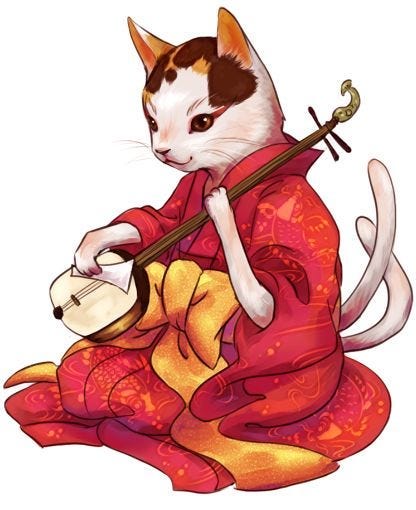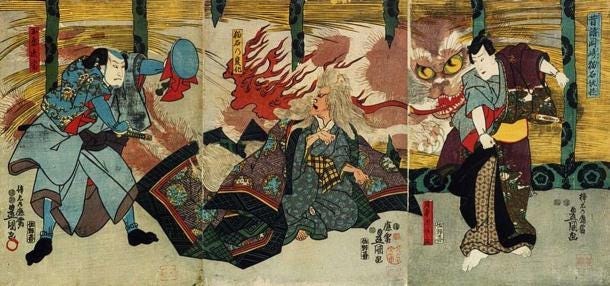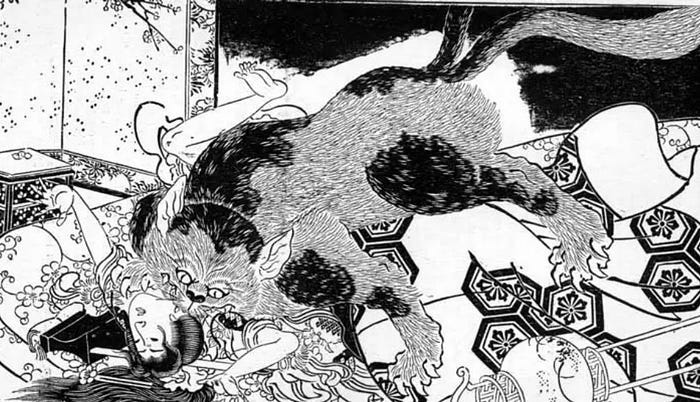Yōkai: Nekomata (猫また cat spirit)
According to legend, it is said to be the result of a domestic cat that lived for too long, becoming old and wise enough to develop supernatural powers and physical changes.
The nekomata is a type of cat yokai that originates from Japanese folklore. Its first mention was in Yoshida Kenko’s literary jottings during the Kamakura period from 1185 to 1333. In his scroll, Tsurezure-gusa, Yoshida stated that a nekomata exists deep in the mountains and feeds on human flesh. It caused fear among the people, although there were no accounts of supernatural abilities of the nekomata at that time.

What is Nekomata
Nekomata is a mythical creature from Japanese folklore that has the appearance of a cat with two tails. According to legend, it is said to be the result of a domestic cat that lived for too long, becoming old and wise enough to develop supernatural powers and physical changes. In many stories, the Nekomata is portrayed as a shape-shifter, able to transform into a human or other creatures, and is often associated with dark magic and evil intentions. The Nekomata is known for its ability to control the dead and communicate with the spirits, and it is believed that the creature brings bad luck and misfortune to those who cross its path.
Many people mistake the nekomata for the bakeneko. While the two have the same original life of being house cats before transforming into beasts, the nekomata are more hostile. Furthermore, not all bakeneko are malevolent while all nekomata definitely are. It is also believed that the nekomata are more able to speak human language in comparison to the bakeneko. Due to their larger size, the nekomata are also able to cause more damage and wreak havoc in comparison to the bakeneko.
Despite its malevolent reputation, the Nekomata remains a popular figure in Japanese folklore, inspiring countless stories, art, and entertainment throughout history.
Legend of Nekomata
During the Edo period, the folk legend evolved, and the size of the nekomata increased with each retelling of the story. It was described as bigger than a wild boar and as huge as a panther or lion, with its growl resounding through the mountainous regions. It was during the Middle Edo period that the idea of domesticated cats turning into the nekomata first appeared. Scholars further increased the popularity of this belief through their essays about the mysteries of cats.
One of the most famous stories related to the nekomata was The Nekomata Fire, which was among the many stories compiled in the 1708 Yamato Kaiiki or Mysterious Stories from Japan. The tale talks about how the house of a samurai was taken over by a ghost-like haunting that only ended when the house cat of the family was killed (which was considered a feat) where it was revealed to have two tails.

Nekomata in the Mountain Regions
The history of nekomata dates back to the early years of the Kamakura period in Japan, specifically in the year 1233. During this time, a scroll called “Meigetsuki” documented a nekomata’s evil acts in Nanto, now known as Nara Prefecture. This was the first literary mention of the nekomata, which was described as a monster living in the mountains with the eyes of a cat and the body of a large dog. It was believed that nekomatas would prey on humans who ventured into the mountains, and their attacks depended on various factors such as how deep the person was in the mountains.
Nekomatas were known for their cunning and used several tricks to lure people into the mountains, such as mimicking the sounds of people in distress. Once they lured their victims, they attacked and consumed them. They were also capable of transforming into human form and could mimic the appearance of a victim’s loved one in distress to deceive and attack their prey. The descriptions of the nekomata were terrifying and contributed to the belief that they were evil creatures.
The Vampire Cat of Nabéshima
A well-known legend from Japanese folklore tells the story of a Nekomata, a supernatural cat with the power to transform into a human-like creature. The tale begins with a favored geisha who, unbeknownst to her, catches the eye of the Nekomata. One night, as the geisha slept, the Nekomata pounced on her and killed her before burying her body outside.

Assuming the geisha’s form, the Nekomata continued to visit the prince every night, as she had before. However, instead of simply entertaining the prince, the Nekomata drank his blood as he slept, weakening him with every encounter.
Despite the prince’s increasing illness, no doctor could identify the cause. In an attempt to solve the mystery, soldiers were ordered to watch the prince around the clock. However, every night around midnight, they would inexplicably fall asleep, leaving the prince vulnerable to the Nekomata’s visits.
One night, a young soldier offered to help the prince and was tasked with keeping watch. Aware of the soldiers’ previous experiences, the young man devised a plan to stay alert by stabbing himself in the leg every time he felt drowsy.
As the clock approached midnight, the Nekomata appeared once again, assuming the guise of the geisha. However, this time, the young soldier was ready and drew his knife. The Nekomata flashed its yellow eyes at the soldier before quickly disappearing.
This encounter repeated itself for four nights until the soldier became convinced that the geisha with yellow eyes was the cause of the prince’s illness. Despite the soldier’s warning, the prince refused to believe that his favorite lover was capable of harm.
Determined to take matters into his own hands, the soldier devised a plan to confront the geisha. With eight companions hiding nearby, he approached her room and asked her to read a piece of paper. While she was preoccupied, he attempted to stab her with his knife, but the geisha fought back, and the soldiers joined in the fray.
During the struggle, the Nekomata revealed itself, transforming back into a cat and fleeing into the night. The next day, the geisha’s body was found, and the prince ordered the Nekomata to be hunted down and killed.
©Emika Oka
Thank you for reading this.
Your support holds immense significance for a disabled neurodivergent.
If you’d like to show your support, you can consider buying me a coffee here. My collection of eBooks and classic titles is available here. Your kindness is greatly appreciated.
Source
猫又 - Wikipedia
うちの猫も化けるかしら? 日本の妖怪「猫又」その正体を解説 | 和樂web 美の国ニッポンをもっと知る! (intojapanwaraku.com)
年をとると猫股(ねこまた, 猫又)になる~猫に関する迷信や都市伝説を検証する | 子猫のへや (konekono-heya.com)


